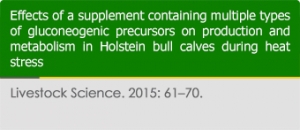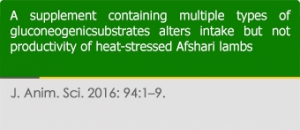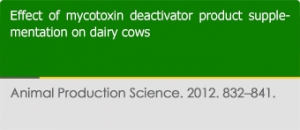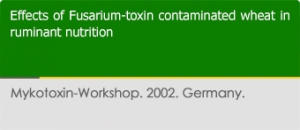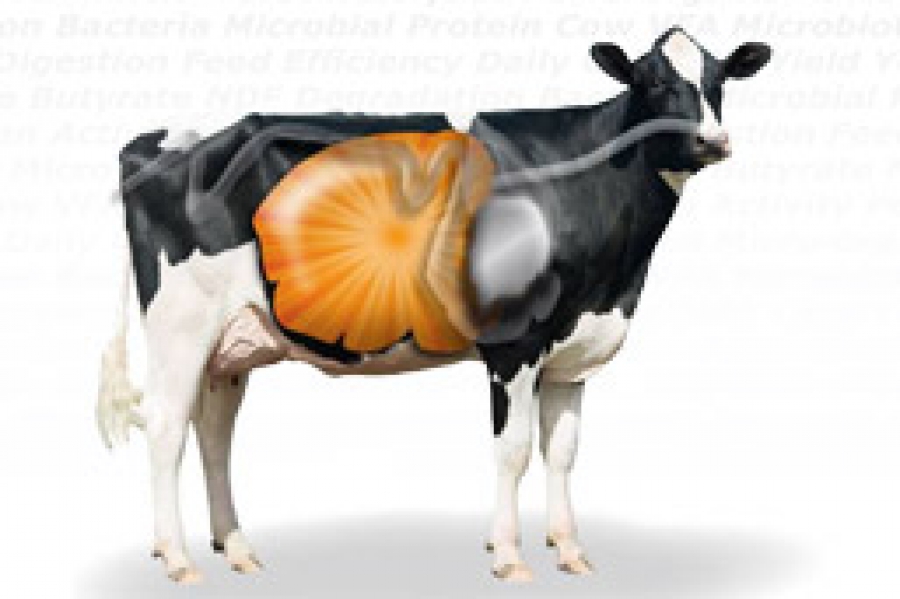Displaying items by tag: دام
M. Hossein Yazdi, H. Amanlou, H.R.Mirzaei-Alamouti, M.T. Harkinezhad, A. Nabipour, E. Mahjoubi, N.Aghaziarati, G.R. Noori, L.H. Baumgard
Glucose appears to be a preferred systemic fuel during heat stress (HS) in a variety of species. Increasing the dietary grain contact can enhance the post-absorptive carbohydrate status, but providing excessive fermentable starch can cause rumen disorders and this is especially true during HS. Current study objectives were to evaluate the effects of a glycerol based supplemental product on growth and metabolic variables in Holstein bull calves during controlled HS. Before the star of the experiment, bull calves (n=14; 163.6 ± 30.1 kg body weight) were subjected to thermal neutral conditions [26.5± 3.4°C and a temperature – humidity index (THI) of 70.4 ± 2.8] for 7 d (period 1; P1). During this period, productive parameters as well as blood metabolites were measured and used as covariates for the subsequent HS period.
E. Mahjoubi, H. Amanlou, M. Hossein Yazdi, N. Aghaziarati, G. R. Noori, C. I. Vahl, B. J. Bradford, and L. H. Baumgard
Thirty-two Afshari lambs were used in a completely randomized design with a 2 × 2 factorial arrangement of treatments to evaluate a nutritional supplement designed to provide multiple gluconeogenic precursors during heat stress (HS). Lambs were housed in thermal neutral (TN) conditions and fed ad libitum for 8 d to obtain covariate data (period 1 [P1]) for the subsequent experimental period (period 2 [P2]). During P2, which lasted 9 d, half of the lambs were subjected to HS and the other 16 lambs were maintained in TN conditions but pair fed (PFTN) to the HS lambs. Half of the lambs in each thermal regime were fed (top-dressed) 100 g/d of a feed supplement designed to provide gluconeogenic precursors (8 lambs in HS [heat stress with Glukosa {HSG}] and 8 lambs in PFTN [pair-fed thermal neutral with Glukosa])
K. F. M. Reed, J. L. Vaughan, L. J. Cummins, D. D. Moore
Liveweight gain, animal health and the effectiveness of a mycotoxin deactivator were studied on an old pasture that contained 61% perennial ryegrass. Sixty-seven percent of the ryegrass population was infected with endophyte (Neotyphodium spp.). The pasture was fenced into two halves and two groups of 28 alpaca male weaners were rotated between the two plots. Nine to 10 Suris and 18–19 Huacayas were allocated to each group. One group was fed a concentrate supplement (100 g/head per day) and the other was fed the same supplement to which was added the toxin deactivator, Mycofix® Plus (5 g/100 g). Mean liveweight gain on the low-quality pasture over late summer and early autumn was not significantly (P > 0.05) different between the groups.
Reed K. F. M., A F, L. J. Cummins, D. D. Moore and A. J. Clark
During February–April, Coopworth ewe lambs grazing a pasture dominated by naturalised perennial ryegrass (PRG) exhibited slight signs of ill-thrift and heat stress. PRG represented 85% of the herbage; 90% of the PRG population was infected with Neotyphodium endophyte. Concentrations of ergovaline and lolitrem B in perennial ryegrass were each within the range 0.5–1.0 mg/kg DM during this period. Two groups of 30 lambs rotated weekly between two paddocks that offered 6 t DM/ha of mature, low-quality pasture. They received an allowance of crushed barley and peas (80 : 20) at 100 g/head per day. One group was treated with a mycotoxin deactivator, Mycofix® Plus, mixed into their mash during processing (5 g/100 g). No sign of ‘staggers’ was observed in the lambs at any time.
Pietri, A., T. Bertuzzi, G. Piva, E. M. Binder, D. Schatzmayr and I. Rodrigues
This study reports the results of an experiment, testing the aflatoxin B1 (AfB1) carry-over from naturally contaminated feed to the dairy cows’ milk in the absence and in the presence of a mycotoxin deactivating product-Mycofix® Plus (MPL). The study was carried out using 18 healthy animals divided into 3 homogeneous groups of 6 animals each. The experimental design was a 3x3 Latin square with three periods of 7 days each without washout periods. The treatments were: (1) control diet without MPL (CTR); (2) control diet with 20 g/cow/day of MPL (T1) and (3) control diet with 50 g/cow/day of MPL (T2). The diet was a Total Mixed Ration (TMR) and 1 kg of a naturally contaminated maize meal (AfB1 = 91.7 ± 4.4 μg kg-1) was included in the diet of each cow. Each animal ingested daily
Kiyothong, K., P. Rowlinson, M. Wanapat and S. Khampa
A total mixed ration (TMR) containing a blend of feedstuffs naturally contaminated with harmful mycotoxins was fed for 84 days to 24 primiparous and multiparous Holstein–Friesian × local dairy cows in a randomised complete block design. The dietary treatments consisted of a contaminated TMR diet plus various levels of the mycotoxin deactivator product (MDP) (0, 15, 30 or 45 g/head.day). Deoxynivalenol (DON), fumonisin B1 (FB1), zearalenone (ZON) and ochratoxin A (OTA) were found in the TMR at levels up to 720, 701, 541 and 501 μg/kg, whereas aflatoxin B1 (AfB1) and T-2 toxin (T-2) were found in the TMR at levels of 38 and 270 μg/kg, respectively. Rumen microbial ecology, ruminal volatile fatty acid (VFA) concentrations, ruminal microorganism populations, feed intake,
Danicke S., D. Gädeken, K.-H. Ueberschar, U. Meyer and H. Scholz
An experiment was carried out to examine the effects of a Fusarium-contaminated wheat (10 mg deoxynivalenol and 0.76 mg zearalenone, ZON, per kg dry matter) on fattening performance and slaughter yields of growing bulls, and on carry over of ZON into tissues and body fluids. In a second study, rumen physiological parameters were investigated in wethers equipped with a rumen fistulae. Moreover, the influences of a detoxifying agent (Mycofix®Plus, MP, Biomin GmbH, Herzogenburg, Austria) were considered as an additional experimental factor beside the contamination of the wheat (uncontaminated control wheat, Fusarium-toxin contaminated wheat). The experiments were designed according to a complete two by two factorial model of ANOVA which required



